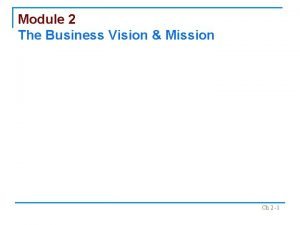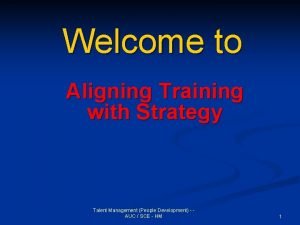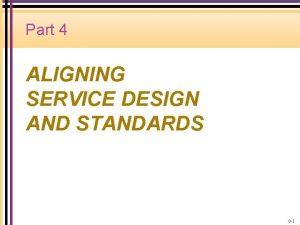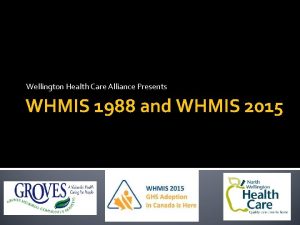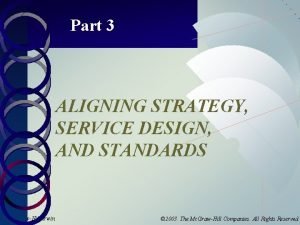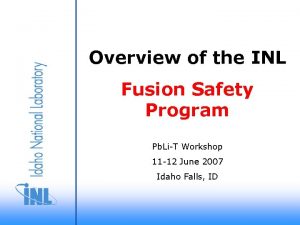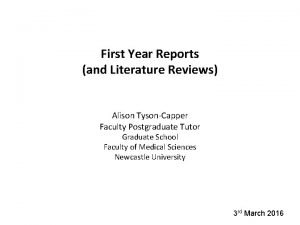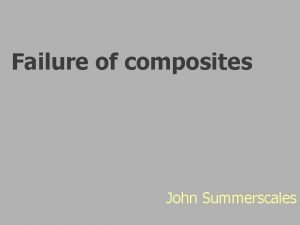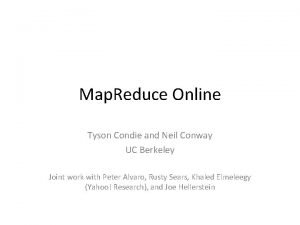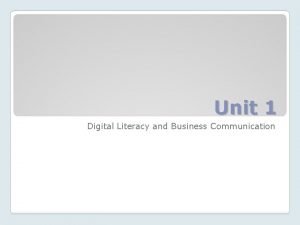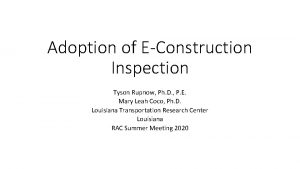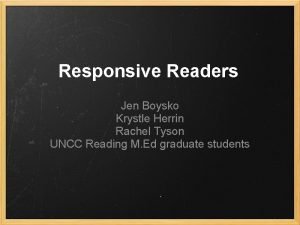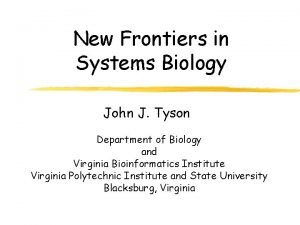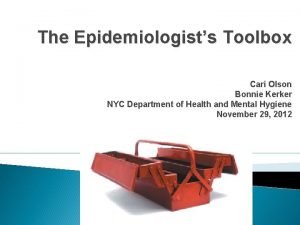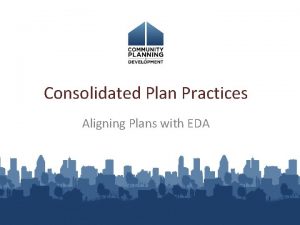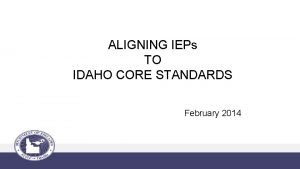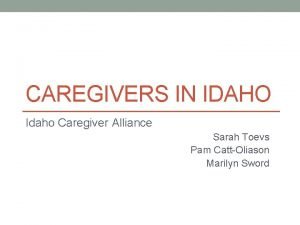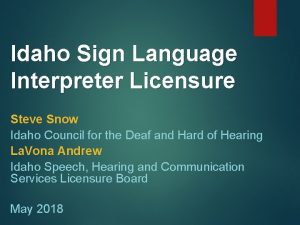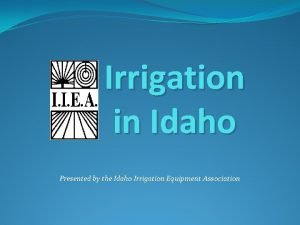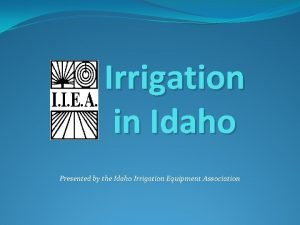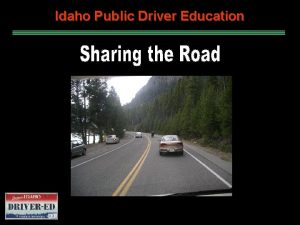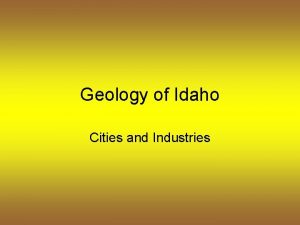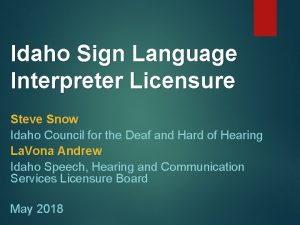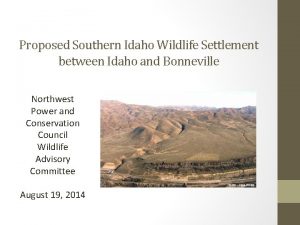Aligning Risk to Mission Tyson Olson Idaho National



















- Slides: 19

Aligning Risk to Mission Tyson Olson Idaho National Laboratory Tyson. Olson@inl. gov 1

Principles of Enterprise Risk Management • Governance Framework is Important • Managers Own the Risk • Transparency Supports Informed Decision Making • Forums for Discussing Risk are Important • Diversity of People and Thought Aids Risk Management • Risk Management Should Be Integrated into Key Agency Processes • Planning Fosters a Culture of Resilience Source: Playbook: Enterprise Risk Management for the U. S. Federal Government

ERM at INL 1. Enterprise Risks are identified using Laboratory processes (MRMs, Senior MRMs, KPIs, Assessments, Etc) as well as top down insights from INL Leadership (e. g. , portfolio review meetings, or strategic planning meetings) 2. Risks are categorized under the following categories based on their primary nature: Strategic, Research/Mission, Operations, Finance, People 3. Risks are tied to the Laboratory Agenda. 4. Risks are ranked according to a common probability and consequence framework. 5. A strategy of monitor, mitigate, or avoid is decided. 6. Risks and associated actions are tracked through a common software tool. 7. The Enterprise Risk Register informs the Integrated Priority List (IPL) process for funding decisions. 8. Risks and the associated actions and strategy are reviewed and updated quarterly as part of the Senior MRM. 3

INL Mission “Discover, demonstrate and secure innovative nuclear energy solutions, clean energy options and critical infrastructure. ” 4

INL Mission Organizations • Nuclear Science & Technology • Energy and Environmental Science & Technology • National and Homeland Security Science & Technology • Advanced Test Reactor • Materials and Fuels Complex 5

Mission Enabling Initiatives 1. 1. Nuclear Energy Competitiveness and Leadership 1. 2. Integrated Fuel Cycle Solutions 1. 3. Advanced Integrated Energy Systems Science & Technology 1. 4. Advanced Design and Manufacturing 1. 5. Enduring Control Systems Cybersecurity Innovation Capabilities 2. 1. Transform How We Perform and Manage Work 2. 2. Build INL's Future Workforce 2. 3. Modernize and Mature INL Information Systems and Services 2. 4. Optimize Cost Management 2. 5. Revitalize Security and Enabling Infrastructure Laboratory Support 2. 6. Achieve Leadership in Safety to Enable Cutting Edge S&T 2. 7. Advance INL's Stewardship of its Environmental Legacy 2. 8. Advance INL's Security 3. 1. INL is a High Value Partner Nationally and in Community, State, and Region Community Engagement 6

Mission Enabling Initiatives 7

Mission Enabling Initiatives 8

Risk Integration

Risk In Performance Reporting 10

Risk In Performance Reporting 11

Risk In Performance Reporting 12

ERM Structure Sr MRM & Enterprise Risk Register Customized Directorate MRMs & Risk Register SLT EES&T F&SS Tech Support Services Applied Engineering Sitewide Utilities Power Maintenance Life Safety Systems

ERM Tool 14

Enterprise Risk Register 1. 1. Nuclear Energy Competitiveness and Leadership Excessive financial burdens from other INL and/or DOE mandates takes resources from the NSUF core mission funding. MFC User-Facility Model Implementation SMR Investments and Deployment 1. 2. Integrated Fuel Cycle Solutions Advanced Fuel Cycle Funding and Policy Uncertainty Internal Spent Nuclear Fuel Management Spent Nuclear Fuel Impasse with Idaho AG 2. 4. Optimize Cost Management DOE and INL misalignment for accounting practices Increasing construction costs 2. 5. Revitalize Security and Enabling Infrastructure Aging infrastructure not positioned to support future R&D Competition for construction human capital resources Deficiency in strategic infrastructure planning Shortage of funding to support enabling infrastructure 15

Performance Reporting Risk Register Business Aging telephony infrastructure Competition for construction human capital resources Cyber Researcher Human Capital Deficiency in advanced manufacturing expertise Increasing competition for human capital Shortage of Cyber Security Operations Personnel Shortage of funding to support enabling infrastructure Timeline of Safeguards and Security personnel onboarding Operational Aging enterprise systems and IT infrastructure Aging infrastructure not positioned to support future R&D Business systems infrastructure increasing fraud risks DOE and INL misalignment for accounting practices ESL Systems Integration Lab Upgrades Failure to meet SCMS Backlog Treatment Commitments High Hazard Safety Increasing construction costs 16

Risk Register Alt HIGH Failure of the ATR Warm Waste Treatment System Failure to Meet Idaho State Settlement Agreement (ISA) Resulting in Fines and Impacts to INL Mission MEDIUM Advanced Design and Manufacturing customer funding risks Adverse Impacts to Significant Cultural Resources or Numerous Repetitive Type 2 Impacts Aging enterprise systems and IT infrastructure Aging infrastructure not positioned to support future R&D Business systems infrastructure increasing fraud risks VERY LOW Deficiency in strategic infrastructure planning Programmatic diversity creates funding obstacles Strengthening CRMO Performance Through Transition to ES&S 17

Risk Register Alt B 000 ENERGY & ENVIRONMENT S&T Computational and Mathematical obstacles Deficiency in advanced manufacturing expertise ESL Systems Integration Lab Upgrades Thermo. Loop funding and construction C 000 NUCLEAR SCIENCE AND TECHNOLOGY Advanced Design and Manufacturing customer funding risks Advanced Fuel Cycle Funding and Policy Uncertainty Political uncertainties related to advanced design and manufacturing prioritization SMR Investments and Deployment Spent Nuclear Fuel Impasse with Idaho AG L 000 PARTNERSHIPS, ENGAGEMENT & TECH DEPLY Lack of engagement from SLT in supporting reputation-building activates Relationships with academic stakeholders SLT engagement of key stakeholders 18

Risk Register Alt H 000 ES&H&Q High Hazard Safety Lab-wide Safety Risks to INL's Environmental Legacy H 500 ENVIRONMENTAL SUPPORT & SERV Failure to Meet Regulatory/Contractual Commitments or INL Mission Due to Staffing Retirements, Transfers, or Promotions Failure to Meet Regulatory/Contractual Commitments or INL Mission Due to Work Planning and Control H 510 PROJECT & PROGRAM SUPPORT Failure of the ATR Warm Waste Treatment System Failure to Maintain Building/Painted Surfaces at ATR, CFA, & MFC Resulting in PCB Releases & Non-Compliance Failure to Meet Idaho State Settlement Agreement (ISA) Resulting in Fines and Impacts to INL Mission Release of Radionuclides from ATR Evap Ponds Above Permit or Regulatory Limits from Liner Leak H 530 REGULATORY & MONITORING SERV Adverse Impacts to Significant Cultural Resources or Numerous Repetitive Type 2 Impacts Failure to Maintain Accurate IRC Radionuclide Inventory and Emissions Failure to Meet NEPA & CRMO Commitments Legacy Deficiencies in Cultural Resource Management Strengthening CRMO Performance Through Transition to ES&S H 540 WASTE MANAGEMENT PROGRAM Failure of Flour to Meet INL Needs for Characterization and Disposal of TRU Waste Failure to meet SCMS Backlog Treatment Commitments Significant deficiencies in INL TRU Program impacting INL’s ability to dispose of TRU waste at WIPP 19
 Vision example for food business
Vision example for food business Market risk credit risk operational risk
Market risk credit risk operational risk Aligning training with strategy
Aligning training with strategy Blueprint for overnight hotel stay service
Blueprint for overnight hotel stay service Aligning hr strategy with business strategy
Aligning hr strategy with business strategy Whmis 1988 pictograms
Whmis 1988 pictograms Aligning brand and culture
Aligning brand and culture Aligning service design and standards
Aligning service design and standards Fusion safety management
Fusion safety management Prrofread
Prrofread John summerscales
John summerscales Tyson
Tyson Unit 1 digital literacy
Unit 1 digital literacy Tyson
Tyson Tyson
Tyson Tyson pillow md
Tyson pillow md Rachel tyson
Rachel tyson John j. tyson
John j. tyson Zoe ann olson
Zoe ann olson Toolbox nyc
Toolbox nyc
